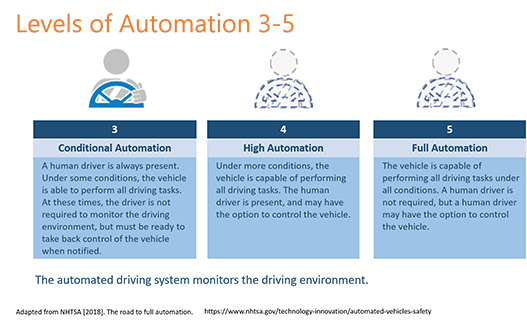Behind the Wheel at Work

Behind the Wheel at Work is a quarterly eNewsletter bringing you the latest news from the NIOSH Center for Motor Vehicle Safety.
Volume 3 Number 3 September 2018
Automated Vehicles: Part 1
Everyone wants to talk about automated vehicles. How much have you heard about this topic as it relates to driving on the job? In this month’s newsletter, you’ll get an overview of what you need to know about automated vehicle technology in the workplace. Stay tuned for Part 2 on management. Access previous newsletters.

We say it often: Crashes are the leading cause of work-related deaths in the United States. That’s why the NIOSH Center for Motor Vehicle Safety exists. In fact, did you know that NIOSH is the only part of the U.S. federal government whose mission includes preventing crashes and resulting injuries for all workers, not just a specific worker group? Get a snapshot of our program—including how we make an impact and who we collaborate with—in a new one-page fact sheet for employers, safety professionals, and workers.
The bottom line: Want to know more about us? Now you can—in 1 page!
Automated Vehicles: Coming Soon to a Road Near You
Media attention goes to vehicles that are being tested in “self-driving” mode all or part of the time, with or without a human driver. In reality, though, vehicle automation is much more complicated – it’s not a question of whether or not the vehicle is automated, it’s the level of automation the vehicle is capable of. Government and industry have adopted a common way to refer to the progression from Level 0 (no automation) to Level 5 (full automation).


The bottom line: The transition to highly-automated vehicles holds great promise to reduce crashes, injuries, and fatalities; to improve transportation options for older persons and persons with disabilities; and to make transportation of freight and passengers more efficient. More information about the changes automation is expected to bring is available from the U.S. Department of Transportation and the Road to Zero Coalition.


Vehicles with automated features such as AEB are becoming much more common on our roads, and cars and trucks that have true self-driving capabilities are being tested in some areas. Not surprisingly, a crash may occur, and when it does, the National Transportation Safety Board (NTSB) is on the scene to conduct an independent investigation, determine the probable cause, and make recommendations for safety improvements.
Automated vehicles are beginning to appear in the accident reports that NTSB issues following an investigation. These online reports, which anyone can access, include a summary and probable cause. You can also view live webcasts of public NTSB meetings where preliminary findings are reviewed before an accident report is finalized.
NTSB has published a final report of a 2016 collision in Florida between a car operating with automated vehicle control systems and a tractor-semitrailer truck. NTSB identified that probable cause was “the truck driver’s failure to yield to the right of way to the car, combined with the car driver’s inattention due to overreliance on vehicle automation, which resulted in the car driver’s lack of reaction to the presence of the truck.”
More recent, preliminary reports from 2018 cover an incident in Arizona involving a vehicle with automated features which struck and killed a pedestrian, and a fatal 2018 crash in California of an electric passenger vehicle with automated driving features.
The bottom line: You can learn about ongoing and completed investigations of automated-vehicle crashes by visiting the National Transportation Safety Board’s website.

This October 1-5, we’re observing Drive Safely Work Week, an annual campaign sponsored by the Network of Employers for Traffic Safety. Access campaign materials for more information. The bottom line: 20% of all reported vehicle crashes occur in parking lots.

What type of workers are at risk of a crash while driving on the job? Our new animated image (GIF) has the answer to this question and describes priority worker audiences for the NIOSH Center for Motor Vehicle Safety. Download the Driver GIF to promote workplace road safety.
Questions? Comments? Email kur4@cdc.gov.

What motor vehicle safety topics do you want to read about? Tweet or email us to share your thoughts.
Enter your email address to receive research updates, links to motor vehicle safety resources, practical tips on workplace driving, and news about upcoming events.

